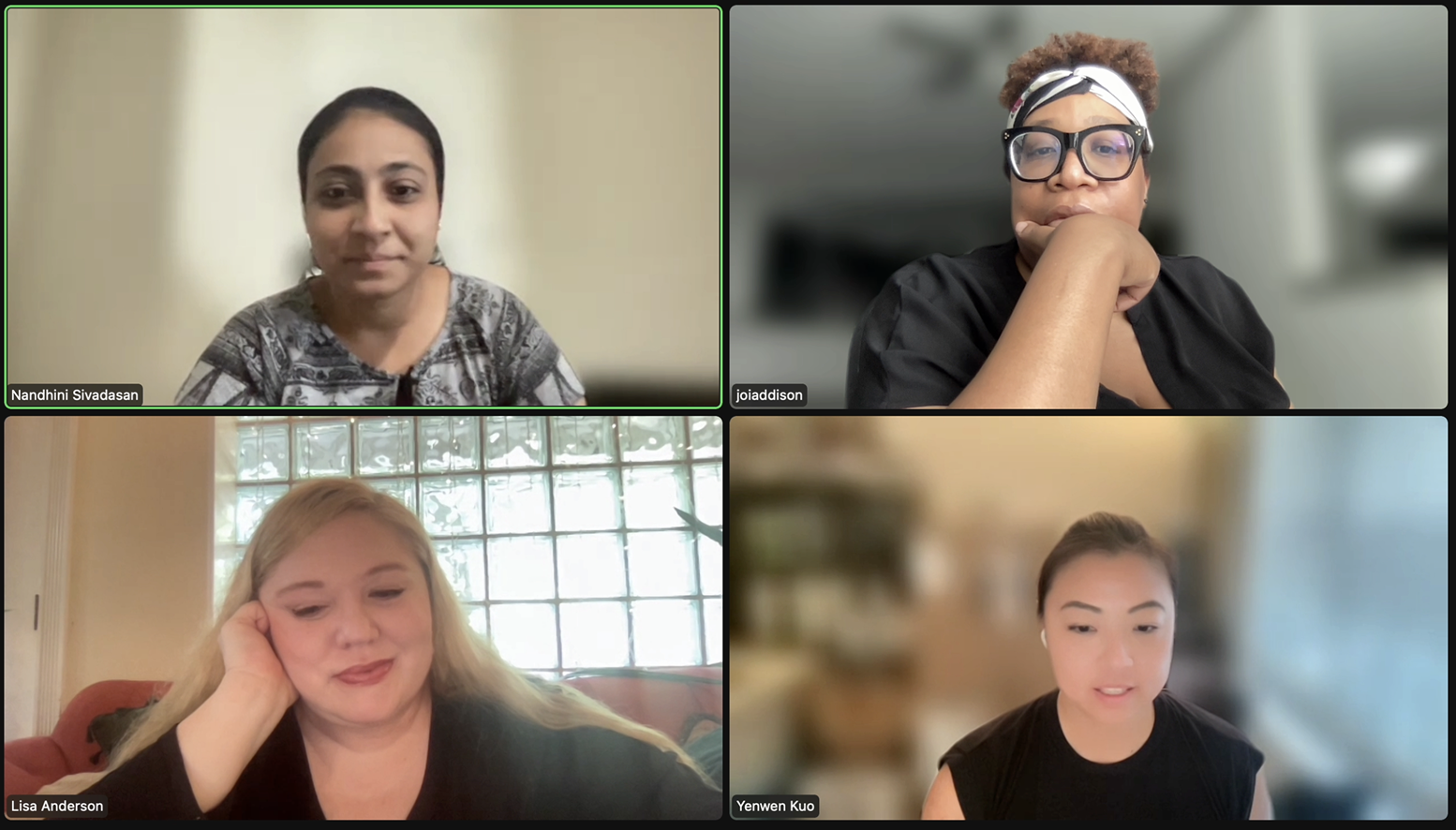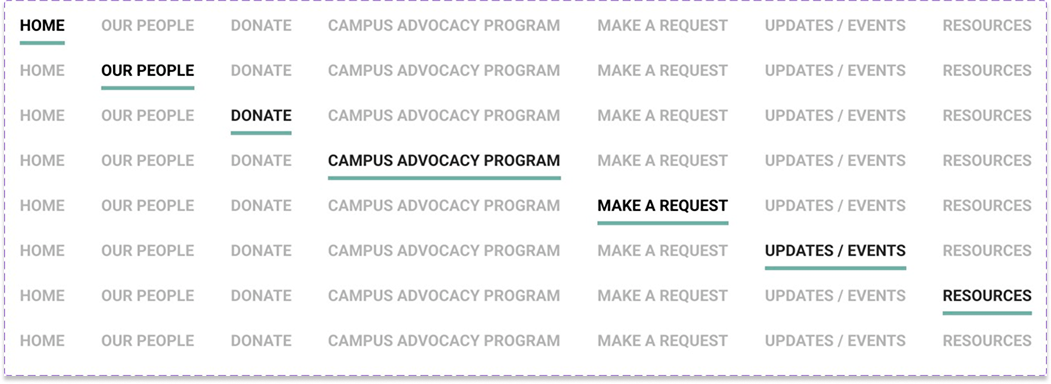UX/UI CASE STUDY : ATLANTA WOMEN FOR EQUALITY
PROJECT SCOPE
Redesign of website
TOOLS
Miro
Figma
Adobe Illustrator
Zoom
Google Drive
ROLE
UX Designer (Research, Visual Design, Interaction Design, User Testing)
TEAM
Joi Addison
Nandhini Sivadasan Yenwen Kuo
with feedback from the mentor and peers
DURATION
3 Weeks
Committed to empowering women students by ensuring their legal rights to equitable treatment and equal opportunities, we work to shape the education system with true gender equity at its core. Our mission is carried out through free legal representation for women facing gender discrimination in education—especially in cases of campus sexual violence—and by advocating for stronger legal protections and expanded educational opportunities through public policy efforts.
PROJECT OVERVIEW
PROBLEM
The website's user interface and design are not effectively communicating the organization's mission and services.
RESEARCH
Research allows me to gain a deep understanding of users—not just their immediate frustrations, but also their hopes, fears, abilities, limitations, reasoning, and goals. This foundational knowledge is essential for creating effective solutions in later stages.
To ensure research remains focused and informs the responsive website design, it is crucial to establish a research plan before diving into the process. Our approach included a stakeholder interview, a survey (with 22 responses), and four qualitative interviews.
STAKEHOLDER INTERVEIW QUESTIONS
Can you tell us more about your organization and its goals?
Are there any new programs not currently listed on your website?
What elements of your website’s current structure would you like to keep, and why?
What features would you like to add or change?
How do most people discover your organization?
How directly does your organization work with schools and campuses?
How do you receive most of your donations? What motivates people to donate? How would you like us to improve this feature?
Are there any staff members or cases you would like to highlight?
Do you have any key quotes or mottos you’d like featured on the site?
How do you typically recruit volunteers, and how does your volunteer process work?
What role would you like the website to play for your organization? Which areas need the most improvement?
Do you have a preferred visual style or any videos you'd like to include to help first-time visitors better understand your mission?
Are there any websites you admire and would like to take inspiration from?
Are there additional people, such as a designer you work with, whom you recommend we interview?
STAKEHOLDER INTERVIEW
SOLUTION
Developed a visually engaging design to enhance user experience, communicate the mission effectively, and boost donations.
DESIGN PROCESS
IMPORTANT NOTES
Lisa is a one-woman team managing multiple roles.
Improve the process for submitting internship requests, case reviews, and general inquiries.
Offer clear information on legal rights and provide resource links.
Fix the broken direct donation link.
Prefers Art Deco and Art Nouveau aesthetics.
AFFINITY DIAGRAM
We created an Affinity Diagram, from the data collected from our survey and qualitative interview.
SURVEY/QUALITATIVE INTERVIEW QUESTION
How frequently do you volunteer your time with non-profit organizations?
What factors or values influence your decision to volunteer?
How often do you make financial contributions to non-profit organizations?
What motivates you to support non-profits through donations?
What information or features would you expect to see on a non-profit’s website to ensure your donation is being used responsibly and effectively?
What is your preferred method for receiving updates and communications from non-profit organizations?
If you prefer to stay informed through social media, which platforms do you actively use?
INSIGHT
The average person volunteers once every three months.
Most people donate to a cause monthly.
Email updates are the preferred method for receiving news and updates.
Instagram is the most popular social media platform for news and updates.
NEEDS
People are more likely to volunteer for causes that personally impact them.
People are more motivated to donate when they feel a personal connection to the cause.
To maintain donor engagement, organizations should provide annual accounting reports, updated photos, and testimonials.
Email remains the preferred channel for news and updates.
USER PERSONA
COMPETITOR ANALYSIS
HEURISTIC EVALUATION
Key Points that need to be addressed during redesign.
CARD SORTING
I first mapped the existing navigation to identify sections that could be reorganized or removed. Then, we added a new section based on the stakeholder's request.
WIREFRAMES
After analyzing and redesigning the current navigation, we created a user flow outlining two key website interactions. Each team member developed a wireframe, and we combined the best ideas from each to create our final prototype.
HIGH-FIDELITY WIREFRAMES
Good navigation is a crucial element of any website. When creating a high-fidelity prototype, I prioritize navigation first, as it plays a key role in user experience and strategy. Effective navigation allows visitors to easily find content, search, and browse while also increasing engagement, encouraging repeat visits, and improving the likelihood of users taking action.
Next, we developed a high-fidelity prototype for usability testing. This step is essential for identifying issues in information architecture and user flows, helping us pinpoint friction points and improve the overall user experience.
USABILITY TESTING
We conducted both in-person and remote usability testing with five participants.
Tested Tasks:
Make a Donation
Submit a Case Request
Find More Resources
All tasks had a 100% completion rate. We recorded any mistakes, slips, and moments of confusion to identify areas for improvement.
With the final prototype completed, I believe the initial design goals have been successfully met.
FUTURE OPPORTUNITIES / NEXT STEPS
Develop an in-house online training program for interns.
Streamline the donation process further.
Showcase the annual budget report.
Implement a 24-hour messenger for immediate help and legal advice.
Expand the forum’s scope to support women beyond campus sexual harassment cases.
Create a mobile-friendly version of the site.













